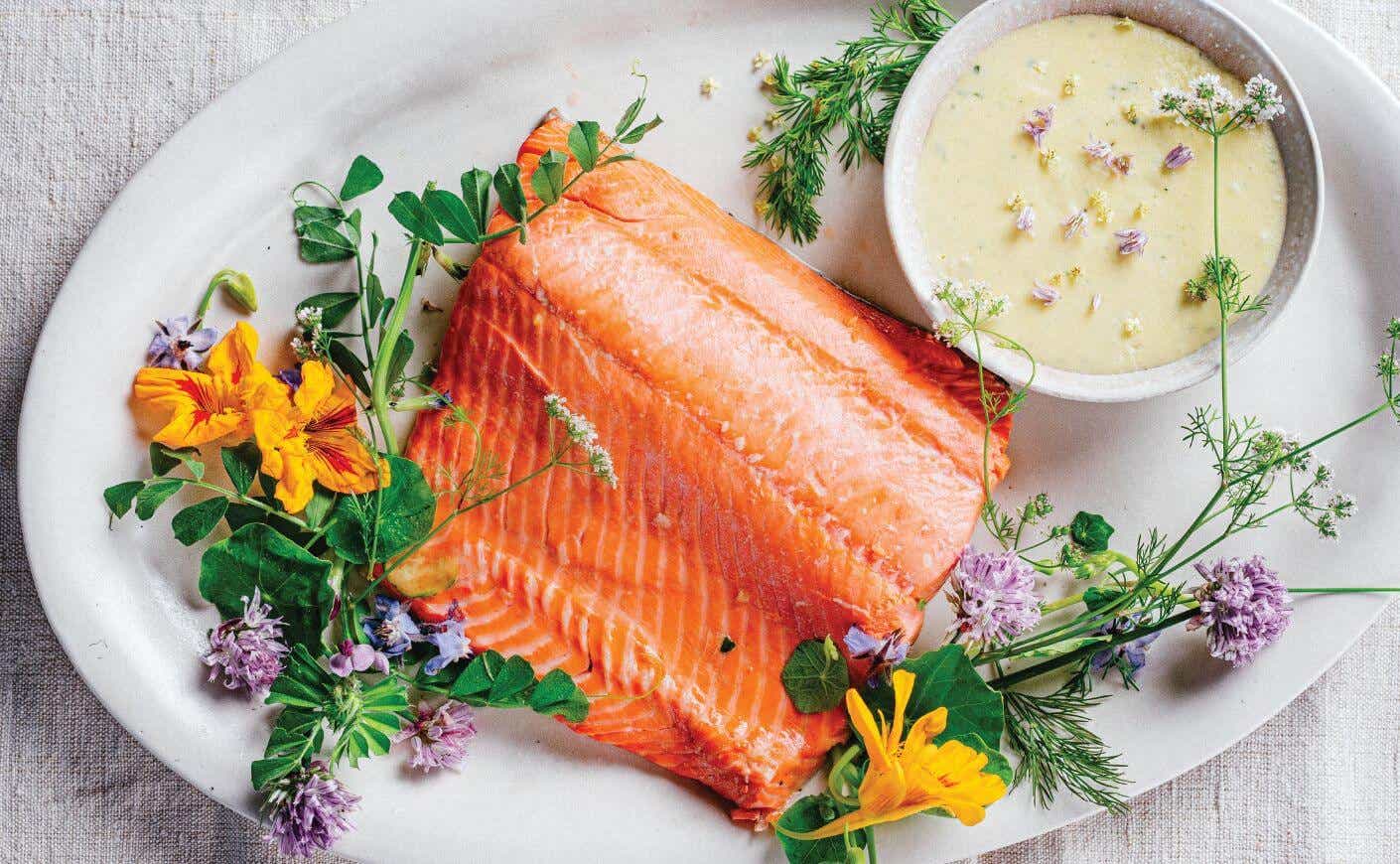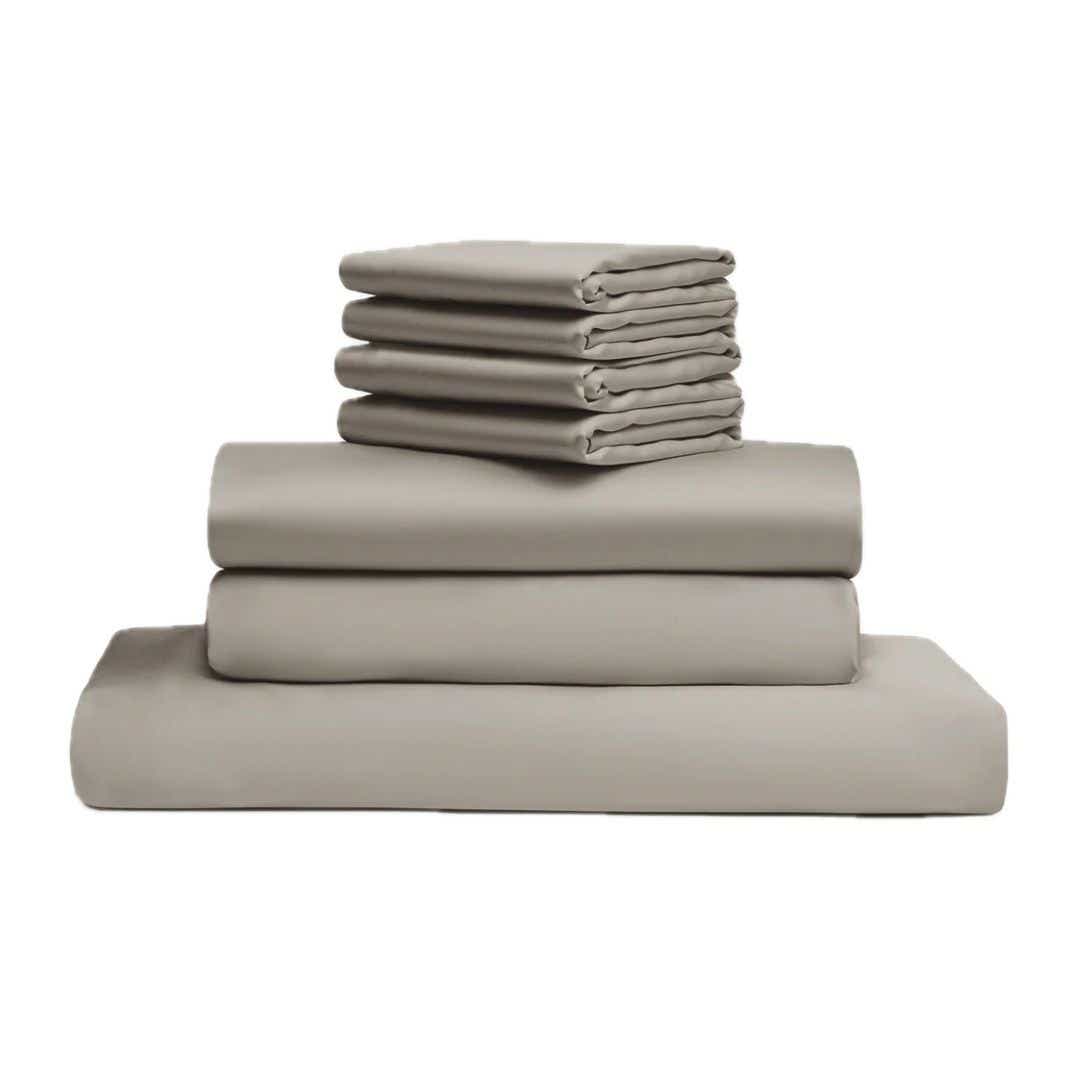By now, you’ve roasted and pan-fried your fair share of salmon. But if you put away your skillet and your sheet pan, you can use this popular fish to achieve new flavors and textures. We’re talking about poached salmon, which sounds (and looks) fancy, but is surprisingly simple to make.
“This salmon is a superb dish, a classic, and my no-fail hollandaise is the one you will make again and again,” writes iconic chef Andrew Zimmern in his fishy tome, The Blue Food Cookbook. “Every cook should know how to make this dish.”
To poach the salmon, you’ll need everyday aromatics like white wine, peppercorns, celery, onion, and herbs. You’ll toss together an easy poaching liquid, then dip your salmon into it for about 15 minutes or so (depending on the thickness of your fillet). Use toppings as you see fit, or take a cue from Zimmern’s creative tips: “I love slicing cucumbers paper thin to create scales to decorate the fish or cover in a mixture of minced herbs and citrus zest. I even love serving this with a mountain of potato crisps on top.”
Potato crisps or no, you can’t serve the salmon without dishing up that stellar hollandaise. You’ll place a stainless steel bowl above a pot of boiling water, then whisk in egg yolks, lemon juice, tarragon leaves, cayenne pepper, and plenty of butter.
As for the final presentation, ZImmern reminds us to go big or go home: “Garnish the platter with a medley of spring vegetables, cooked asparagus, herb sprigs, or all of the above. This is a show-off dish, so show off!”
Andrew Zimmern’s Poached Salmon with Hollandaise
Serves 6-8
Ingredients
- One 2- to 3-pound salmon fillet, skin-off, pin bones removed, tail trimmed off
- Salt
- 3 cups dry white wine
- 1 onion, chopped (about 1 cup)
- 3 celery stalks, chopped (about 1 1½ cups)
- 1 tablespoon whole black peppercorns
- 3 parsley sprigs
- 3 dill sprigs
- 3 tarragon sprigs
- 1 recipe No-Fail Hollandaise
No-Fail Hollandaise
Makes about 1 ½ cups
- Juice of 1 lemon (2 to 3 tablespoons)
- 1 teaspoon dijon mustard
- 2 tablespoons freshly minced fresh tarragon leaves
- ⅛ teaspoon cayenne pepper
- 5 egg yolks
- 1 cup (2 sticks) butter, cut into ¼-inch pieces
- Salt
Instructions
- For the salmon: Season the fish with salt and set it aside.
- Make the poaching liquid (court bouillon in French) by combining the wine, onion, celery, peppercorns, parsley, dill, tarragon, and salt to taste in a fish poacher or deep rectangular pan large enough to hold the salmon. Add 3 to 4 inches of water and bring to a boil. Place the salmon fillet on an oiled piece of butcher paper with edges that stick out over the sides of the pan, or on a large piece of cheesecloth. (This is so you can remove the fillet without it breaking if you don’t have the specialized pan called a salmon poacher.) Lower the salmon fillet into the liquid and bring the court bouillon back to a simmer. Lower the heat to maintain the barest simmer possible, cover, and cook gently until the salmon is just cooked through, 12 to 16 minutes, depending on the thickness. Turn off the heat and let the fish rest in the liquid for 2 to 3 minutes.
- Lay a towel next to a platter. Using the paper or cheesecloth, remove the fish from the liquid and place on the towel. Dab the fish dry as best as possible. Carefully transfer the salmon to a platter. Garnish with any accoutrements you’d like, such as cucumber slices or herbs and citrus.
- Serve the salmon warm with the No-Fail Hollandaise.
- For the No-Fail Hollandaise: Set up a pot of gently simmering water over which you can rest a stainless-steel bowl. In that bowl, whisk together 1 ½ tablespoons water, the lemon juice, mustard, tarragon, cayenne, and egg yolks until thickened, 2 to 3 minutes. Whisk continuously, removing the pan from the heat source briefly if it gets too hot. Add the butter, whisking constantly until the butter is fully incorporated, about 2 minutes. Season with salt. Whisk over the heat to make sure the sauce is warm. Your yolks are already cooked and stabilized!
- If the sauce is too thick, whisk in warm water, 1 teaspoon or so at a time, until the sauce is just pourable.
- This sauce can be made ahead by about an hour if kept stored in a plastic quart container in a pot of hot water. You can store leftovers in an airtight container in the refrigerator for up to a week and reheat in a double boiler over low heat.
Excerpted from the book The Blue Food Cookbook, provided courtesy of William Morrow, an imprint of HarperCollins Publishers. Copyright © 2025 by Fed By Blue. Reprinted by permission.












